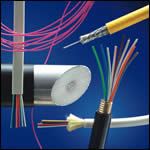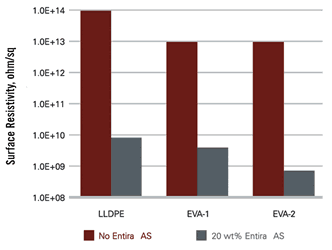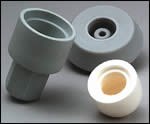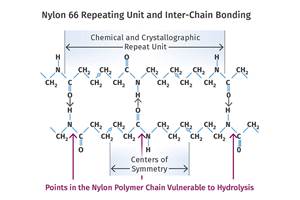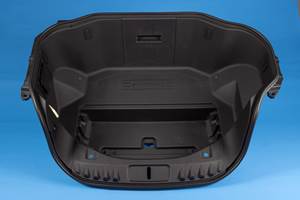NPE 2006 News Wrap-Up: Chemicals and Additives
There were new additives for every need at NPE 2006: Make your plastics prettier with new colorants. Make them stronger with new fillers and reinforcements. Make them lighter with foaming agents. Or just make them go away with improved purging agents and biodegradable masterbatches.
Materials exhibits may be getting harder to find at NPE, but not so for additives. Processors at the show were treated to an eyeful of new colorants and additives of all types—antistats, nucleating and foaming agents, compatibilizers, lubricants, fillers, reinforcements, purging agents, mold releases, slip agents, and biodegradation promoters. More new additives were covered in our June show preview but won’t be repeated here.
Colors for clears
Several new colorants at the show are aimed specifically at transparent plastics. For example, PolyOne launched the PProTint and PProTint Plus colorant families specifically for tinting and enhancing the transparency of clarified PP (see front cover). They reportedly offer improved light stability and in most applications do not bleed, creep, or migrate. PProTint colorants offer new color options for large storage containers. FDA-approved PProTint Plus colorants (priced slightly higher) are said to be even brighter and clearer and suited for infant items such as pacifiers and “sippy cups” as well as neutraceutical/pharmaceutical containers and food packaging.
PProTint presents an alternative for clear PP applications that have been dominated by Milliken’s ClearTint products introduced three years ago. PolyOne says its new entrants use different pigment chemistry and are less expensive.
Also new for clarified PP are Gemtones FDA-approved, non-fluorescent, polymeric pigments from Dayglo Color. They reportedly allow formulators to create clear, haze-free, non-warping colors.
Silberline showcased its new Silvet HC and P pigments, which are designed to maintain the transparency and DOI of clear, glossy plastics when pigmented with Silberline’s aluminum pigments. Normally, some clarity and gloss are lost when using aluminum pigments.
Holland Colors launched a clear amber colorant for PET beer bottles. Amberguard is said to block 92% to 99% of uv and visible light.
More specialty colorants
Other colorants were introduced at the show for reducing the cost of replacing heavy-metal pigments in PVC wire and cable jacketing. PolyOne came out with a new family of lead-free colorants to match the full Munsell color pallette, with a specific emphasis on red, orange, and yellow, where it has been the most expensive to replace lead counterparts. Says product manager Mike Masterson, “The costs are now more compatible, perhaps 10% to 20% higher, versus 50% to 60% higher for previous offerings.”
These colorants are said to perform as well as their lead counterparts. They have very strong hues and were developed for very white PVC compounds. Because of their strong hues, they can be processed in very thin extrusions—10 to 12 mils or less.
Another specialized coloring application addressed by PolyOne is foamed plastic lumber. Proliferating applications for natural-fiber-based composites have increased the need for multi-additive packages, say company officials. Its new SmartBatch products can include pigment, uv stabilizer, antimicrobial, compatibilizer/coupling agent, and lubricant in one pellet.
DuPont’s new Entira AS polymeric antistat dramatically reduces surface resistivity of 50-micron blown films at 50% R.H. The additive was dryblended with three different polyolefin resins.
In other colorant news, two special-effect colorants were introduced by Silberline: Extra Sparkle Silvex/Silvet for producing 3D metallic pinpoint sparkle effects, and Sparkle Silver Ultra, which can give the appearance of anodized aluminum, brushed steel, or stainless steel.
EMD Chemicals Inc. showcased Xirallic glittering luster pigments, the newest of its special-effects pigments, produced by German parent company Merck KGaA. With a distinctive star-like glimmer, Xirallic is composed of aluminum oxide platelets coated with TiO2. It reportedly can produce pure white or very clean transparent colors and has unusually high color strength with interference pigments.
RTP Co. showcased an expanded range of its new Unicolor line of universal color masterbatches. Now totaling 42 colors, they boast extremely low letdown ratios—1% to 2%.
Day-Glo Color introduced Gloprill, a fluorescent pigment said to exhibit unsurpassed plateout resistance in polyolefins.
And for rigid PVC, Holland Colors came out with the Holcovinyl LQ liquid coloring system.
Permanent antistats
DuPont launched the first of a new family of ionomer polymeric antistats. Entira AS additives confer not only antistatic properties but also high-frequency weldability and moisture permeability in polyolefins used for packaging health and beauty aids, foods, beverages, electronics, and stationery. Because they do not contain ingredients such as glycerol that fume easily, they are suitable for blown film and for injection and blow molding.
Compared with surfactant-type antistats, Entira AS reportedly provides permanent antistatic properties with little bleeding, excellent processability, and miscibility with polyolefins at levels of 10% to 20%. Entira AS can be dryblended with the base polymer.
Addition of only 15% of Entira AS to the outer layer of two-layer bottles made from HDPE, LLDPE, or PP produces a bottle surface that is much less prone to friction-generated static charges. Surface resistivity drops from 1014 to 1010 ohm/sq.
Make PE clearer, glossier
Milliken & Co. marked a significant expansion of its nucleator and clarifier business with the launch of its first hyper-nucleating agent designed for PE blown film, including shrink, stretch, greenhouse, and overwrap films. Hyperform HPN-20E reportedly cuts haze by 40% in LLDPE and increases gloss by 100%. It’s said to be a more efficient, simpler alternative to blending LDPE with LLDPE. HPN-20E also provides significant improvement in moisture barrier, according to Milliken, which opens up new potential packaging constructions for ex tended shelf life.
In recent trials on Battenfeld Gloucester’s production-scale laboratory lines in Gloucester, Mass., nucleated LLDPE films demonstrated a 30% increase in MD tear and a 20% im provement in stiffness compared with typical LLDPE/LDPE blends, while maintaining dart impact. What’s more, faster crystallization with nucleation resulted in a 7% increase in line speed. Nucleation also reportedly contributed to film quality improvements such as reduced streaking.
Lubricate rigid PVC
Honeywell Specialty Additives launched a new family of custom-formulated lubricants for rigid PVC pipe, siding and window/door profiles. Rheochem HPL blends of paraffin, PE waxes, and other ingredients can significantly increase output rates, reduce plate-out, and allow higher filler levels, according to global business manager Michael Calicchio. They also allow processors to extrude PVC at lower temperatures and thereby reduce burning, discoloration, power consumption, frequency of maintenance shutdowns.
From 27% to 35% faster molding cycles are promised by a “universal” masterbatch from E-Z Color Corp. Its Cycle Enhancer comes in two forms for black or natural products and a third that includes color pigments.
A new flow-enhancing masterbatch in a PE carrier reportedly raises throughput of high-stiffness HDPE and LLDPE and reduces energy consumption by the extruder. PM13030 from Techmer PM is said to improve processing even with highly viscous resins such as HMW-HDPE, without affecting the physical properties of extruded or molded products. It is aimed at food packaging, sheet, and pipe.
Additives for foaming
New blowing-agent concentrates from PolyOne are aimed at polyolefins, PS, ABS, PC, PPS, PPO, and some nylons. OnCap PolyFoam masterbatches include endo- or exothermic chemical agents or both. Applications include building and construction products, automotive trim, totes and pallets, and plastic lumber.
Meanwhile, Reedy International unveiled what’s said to be a unique foam stabilizer additive system for use in wood-plastic composites and food packaging. In wood composite, Saftec AS reportedly improves dispersion of fibers and allows for high loading levels without burning or charring. It is also said to improve processability by promoting melt homogenization, metal release, and thermal stability.
Low use levels of this additive are said to minimize or eliminate edge tear and shear burning and to serve as an acid and odor scavenger. It reportedly also reduces discoloration and degradation from bacterial and fungal attack.
Compatibilize scrap
Another reportedly unique additive compatibilizes PE-based recycle streams for use in plastic lumber and other products. Fusabond E EC-603D is a new anhydride-functional ethylene copolymer from DuPont Packaging & Industrial Polymers. Because the functionality is built into the polymer backbone, rather than grafted on after polymerization, this copolymer has significantly higher anhydride levels, which provide more reactive binding sites, says says marketing manager Megan O’Brien. That gives this additive a wider operating window for coupling EVOH, moisture, lubricants, nylon, and even fiberglass in the mix, which allows users to buy cheaper recycle vs. more costly “cleaner” reclaim.
Tests show that only 0.5% of the new copolymer increases notched Izod impact strength of wet blends more than four times as much as 1% of a workhorse grafted modifier. Because it helps bind the polar contaminants into the polymer matrix, reduced die build-up is also claimed.
Kenrich Petrochemicals introduced Ken-React/CP-03, a new coupling agent to enhance bonding of glass, Kevlar, and carbon fibers to thermoset substrates including polyester, vinyl ester, epoxy, and polyurethane.
Nano-fillers and more
The hottest concept in filled plastics is nanocomposites. Nanocor, Inc. featured its new nanoMax series of polyolefin nanoclay masterbatches containing 40% to 60% of the company’s Nanomer montmorillonite nanoclays. Designed for PP, TPO, LL/LDPE, and EVA, these dust-free pellets are said to improve mechanical properties 8% to 12% and flame resistance at only 2% to 8%.
And Kenrich has new Ken-React/QB 046, a blend of proprietary pyrophosphate titanates designed to exfoliate nanoclays in plastics such as PP. It is said to result in improved flow, mechanical properties, and flame resistance.
Meanwhile, Expancel, Inc. launched a new series of its Expancel expandable hollow thermoplastic microspheres for polyolefins, PS, and PVC compounds. They reportedly offer less yellowing when processed at high temperatures. They also offer cost savings of as much as 10% over the grades they replace. New grades are 930 DU 120 and 950 DU 120, and their masterbatch forms, 930 MB 120 and 950 MB 120.
3M’s Specialty Materials Div. launched what are said to be the first hollow glass microspheres that can withstand injection molding and extrusion pressures of 30,000 psi. At 17 microns diam., 3M’s iM30K spheres are said to be 66% stronger than its previous high-strength glass microspheres of about the same size, which have crush strength of up to 18,000 psi.
According to 3M, a recent Hyundai development project found that an auto instrument-panel support of PP filled with iM30K achieved a 16.8% weight saving and 50% lower part cost vs. PC/ABS. The PP compound also had better flow than PC/ABS and better dimensional stability than talc-filled PP.
Potters Industries introduced Sphericel very-low-density (0.34 to 0.60 g/cc) hollow glass microspheres, which are said to reduce weight and warpage, improve flow, and add thermal insulation and sound deadening.
A new grade of chopped-strand fiberglass for high-temperature thermoplastics like PPS, polysulfones, and PEEK was introduced by Johns Manville. Thermoflow EC 10 768 is a 4-mm densified grade that reportedly minimizes fuzz and fines and has better hydrolysis resistance than other high-temperature fibers.
Nyco Minerals launched Nyad 5000, an ultra-fine wollastonite that is chemically modified for good adhesion of plating or paint on nylon and PBT for automotive lamp housings and bezels. Nyad 5000 is said to give higher surface reflectivity and lower CLTE than fine talc, calcined clays, and other competitive fillers, resulting in lower scrap during molding and finishing.
Purging hot runners
Chem-Trend launched the Lusin Clean family of granular, low-odor, low-smoke chemical purging compounds. Recent field trials at two custom molders highlight the performance of the two newest grades, G 315 and G 320, designed for purging injection machines and hot runners of polyolefins and engineering thermoplastics, respectively. G 315 was used to purge a machine to change from a black 10% glass-filled PP to a natural HDPE. G 315 outperformed the previously used purging agent by reducing initial start-up scrap to only 10 min (seven cycles) vs. 2 hr (85 cycles). In four days of production, G 315 resulted in a 9% reduction in total scrap generation for one tool. A total of $12,500/yr savings were estimated from reduced scrap and downtime.
Another molder evaluated G 320 when transitioning from a black PC/PBT to a yellow part. About 9.7 lb of G 320 was needed to clean the barrel and return to streak-free production in 22 min, compared with 50 lb and 117 min with the previously used purge. During a three-day run of 1700 parts, scrap due to color streaks was only 0.17% (3 parts) with G 320 vs. 3.17% (54 parts) for the competing purge. Estimated savings would be $32,000/yr in material, labor, and overhead.
Mold release agents
Three new series of Incromold internal mold releases in bead form were showcased by Croda, Inc. Series F is designed for LL/LDPE and HDPE. It reportedly provides up to 30% faster cycles, improved surface finish, and fewer rejects. Similar benefits are claimed for the S series for polyolefins and nylons, and the T series, which is suited to ABS and nylons.
Franklynn Industries showed new mold releases for rotomolding that reportedly reduce scrap rates by cutting warpage and preventing pre-release. Diamonkote is a water-based solution with nearly zero VOCs for polyolefins, PC, nylon, and other thermoplastics. It can be applied to ambient or hot molds.
Other additives
A slip agent for PET and PBT film, sheet, and injection molding was launched by Croda. Incromax PET 100 in pastille form reportedly reduces coefficient of friction at very low levels.
Two-year-old Bio-Tec Environmental featured its proprietary Bio-batch biodegradable additive masterbatches, which enable microorganisms in the environment to digest plastic films and molded bottles within 1 to 5 yr. These products contain several bio-active compounds that can be added to polyolefins, PS, and PET without affecting physical properties or product shelf life, the company claims.
Related Content
Prices Up for All Volume Resins
First quarter was ending up with upward pricing, primarily due to higher feedstock costs and not supply/demand fundamentals.
Read MoreTracing the History of Polymeric Materials, Part 26: High-Performance Thermoplastics
The majority of the polymers that today we rely on for outstanding performance — such as polysulfone, polyethersulfone, polyphenylsulfone and PPS — were introduced in the period between 1965 and 1985. Here’s how they entered your toolbox of engineering of materials.
Read MoreWhat is the Allowable Moisture Content in Nylons? It Depends (Part 1)
A lot of the nylon that is processed is filled or reinforced, but the data sheets generally don’t account for this, making drying recommendations confusing. Here’s what you need to know.
Read MoreAutomotive Awards Highlight ‘Firsts,’ Emerging Technologies
Annual SPE event recognizes sustainability as a major theme.
Read MoreRead Next
See Recyclers Close the Loop on Trade Show Production Scrap at NPE2024
A collaboration between show organizer PLASTICS, recycler CPR and size reduction experts WEIMA and Conair recovered and recycled all production scrap at NPE2024.
Read MoreFor PLASTICS' CEO Seaholm, NPE to Shine Light on Sustainability Successes
With advocacy, communication and sustainability as three main pillars, Seaholm leads a trade association to NPE that ‘is more active today than we have ever been.’
Read MoreBeyond Prototypes: 8 Ways the Plastics Industry Is Using 3D Printing
Plastics processors are finding applications for 3D printing around the plant and across the supply chain. Here are 8 examples to look for at NPE2024.
Read More




